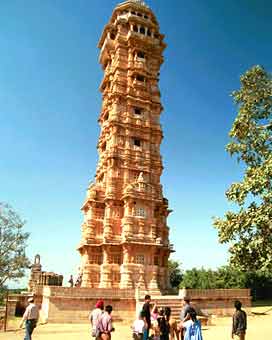Chittaurgarh Travel Guide:

Introduction
Chittorgarh is a city and a municipality in Rajasthan state of western India. It lies on the Berach River, a tributary of the Banas, and is the administrative headquarters of Chittorgharh District and a former capital of the Sisodia clans of Rajputs of Mewar.
Fiercely independent, the fort of Chittor was under siege thrice and each time they fought bravely and thrice Jauhar was committed by the ladies and children, first led by Rani Padmini, and later by Rani Karnavati.[1] Chittorgarh is home to the Chittorgarh Fort the largest fort in India.
History
Chittorgarh is the epitome of Chattari Rajput (Indian warrior caste) pride, romance and spirit for people of Chittor always chose death before surrendering against anyone. It reverberates with history of heroism and sacrifice that is evident from the tales still sung by the bards of Rajasthan. Though it can now be called a ruined citadel there is much more to this huge fort. It is a symbol of all that was brave, true and noble in the glorious Rajput tradition.
View of the Tower of Victory, 1927
Historically, it is considered that Chittor was built by the Maurya dynasty in the 7th century AD.[citation needed] It was then named Chitrakut after Chitrangada Mori, a Rajput chieftain as inscribed on ancient Mewari coins. The fort is surrounded by a circular wall which has seven huge gates before one can enter inside the main fort area. Some accounts say that the Mori dynasty was in possession of the fort when Bappa Rawal the founder of the kingdom of Mewar seized Chittor garh (Chittor fort) and made it his capital in 734 AD. While some other accounts say Bappa Rawal received it as a part of the dowry after marriage with the last Solanki princess. After that date his descendants ruled Mewar, which stretched from Gujarat to Ajmer, until the 16th century. Chittor was one of the most contested seats of power in India with probably some of the most glorious battles being fought over its possession. It is famous in the annals of the Mewar Dynasty as its first capital (prior to this, the Guhilots, forerunners of the Mewar Dynasty, ruled from Idar, Bhomat, and Nagda), and renowned in India's long struggle for freedom. By tradition, it remained the Mewar capital for 834 years. With only brief interruptions, the fort has always remained in possession of the Sisodias of the Guhilot (or Gehlot/Guhila) clan of Rajputs, who descended from Bappa Rawal.
The first attack was by Alauddin Khilji in 1303 AD, who was enamoured by the beauty of Padmini of which he had only heard. Rani Padmini preferred death to abduction and dishonour and committed jauhar (an act of self immolation by leaping into a large fire) along with all the other ladies of the fort. All the men left the fort in saffron robes to fight the enemy unto death. Chittorgarh was captured in 1303 AD by Ala ud din Khilji, Sultan of Delhi who led a huge army. Elderly people then had the responsibility to raise the children. It was recaptured in 1326 by the young Hammir Singh, a scion of the same Gehlot clan. The dynasty (and clan) fathered by him came to be known by the name Sisodia after the village where he was born.
Rana Kumbha (1433–68) was a versatile man a brilliant, poet and musician. He built mewar up to a position of assailable military strength building a chain of thirty forts that girdled the kingdom But, perhaps more important was a patron of the arts to rival Lorenzo de Medici, and he made Chittorgarh a dazzling cultural center whose fame spread right across Hindustan.
By the 16th century, Mewar had become the leading Rajput state. Rana Sanga of Mewar led the combined Rajput forces against the Mughal emperor Babur in 1527, but was defeated at the Battle of Khanua. Later in 1535 Bahadur Shah, the Sultan of Gujarat besieged the fort causing immense carnage. It is said that again just like in the case of Jauhar led by Padmini in 1303, all 32,000 men then living in the fort donned the saffron robes of martyrdom and rode out to face certain death in the war, and their women folk committed Jauhar led by Rani Karnawati. The ultimate sacrifice for freedom, Jauhar was again performed for the third time after the Mughal Emperor Akbar captured Chittorgarh in 1568. The capital was moved west to Udaipur, in the foothills of the Aravalli Range, where Rana Udai Singh II (the young heir apparent) had established a residence in 1559. Udaipur remained the capital of Mewar until it acceded unto the union of India in 1947, and Chittorgarh gradually lost its political importance.
Transport
The completed Golden Quadrilateral highway system will pass through Chittorgarh, connecting it to much of the rest of India. Also crossing the East West Corridor (Express Highway). The Chittorgarh is situated at National Highway No. 76 & 79, both the Highways are crossing at Chittorgarh It is well connected with Jaipur, Jodhpur, Indore Junction MG, Indore Junction BG, Indore Mhow, Ujjain, Ratlam, Nagda Junction, Ajmer and Fatehabad by many metre gauge trains. The town still lacks connectivity to Ahemdabad, Bhopal, Gwalior, Ajmer, Jabalpur and Nagpur, so in order to catch trains for further cities one has to reach either Kota, Nagda or Ratlam.
Chittorgarh Fort
The Chittorgarh Fort seated on a 180 metre hill, covers an expanse of 700 acres (2.8 km2). It was constructed by the Mauryans in the 7th century AD. There is also a belief that it was constructed by Bhima of the Pancha Pandavas. This fort was the citadel of many great Rajput warriors such as Rana Kumbha, Maharana Pratap, Jaimal, Patta, etc.